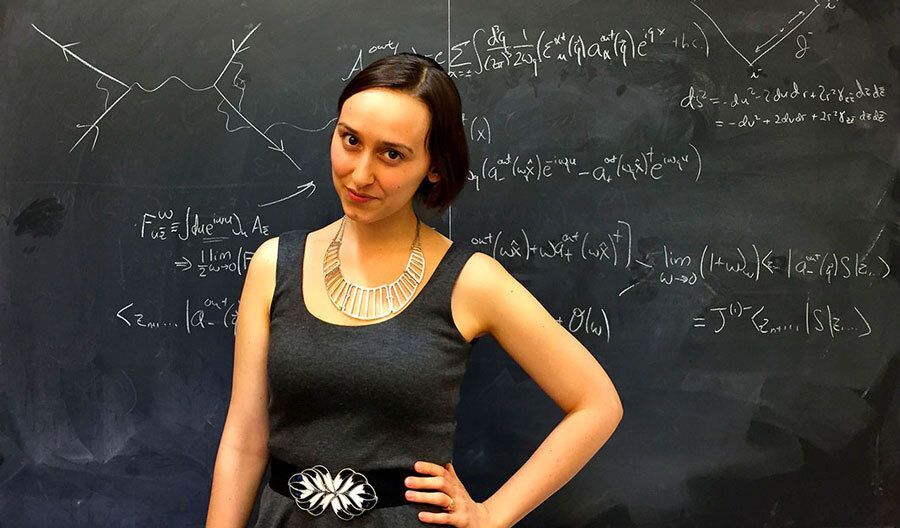Sabrina Gonzalez Pasterski
American Theoretical Physicist

[ Scroll down for English translation ]
Sabrina González Pasterski es una física teórica cubano-estadounidense que ha realizado importantes contribuciones en el campo de la física. Es la primera mujer que se gradúa en Física nº 1 del MIT con un promedio sobresaliente de 5,0 y la segunda candidata al doctorado de la Universidad de Harvard cuya tesis se publica en “Physics Reports.” También ha sido incluida en la lista Forbes 30 Sub-30 de ciencias y en la lista Forbes 30 Sub-30 "All-Star".
Además de sus logros académicos, Pasterski es también una defensora de las mujeres y las niñas en STEM (ciencia, tecnología, ingeniería y matemáticas). Ha hablado en diversos eventos y conferencias sobre la importancia de animar a las niñas a seguir carreras de ciencias y matemáticas. También fue invitada a la Casa Blanca para hablar de su iniciativa "Let Girls Learn" (Dejemos que las niñas aprendan), cuyo objetivo es animar a las niñas de todo el mundo a seguir estudios y carreras STEM.
El trabajo de Pasterski puede cambiar el mundo de muchas maneras. Su investigación sobre el efecto de memoria de espín podría conducir a nuevas formas de detectar y medir las ondas gravitacionales. Su trabajo sobre el triángulo Pasterski-Strominger-Zhiboedov también podría aportar nuevos conocimientos sobre la naturaleza del electromagnetismo.
Pasterski es una inspiración para las jóvenes de todo el mundo. Es la prueba de que todo es posible si te lo propones. Es un modelo a seguir para las chicas que quieren seguir carreras en STEM, y está ayudando a mejorar el mundo.
He aquí algunas formas concretas en que el trabajo de Pasterski puede cambiar el mundo:
Su investigación sobre el efecto de memoria de espín podría conducir a nuevas formas de detectar y medir las ondas gravitacionales. Las ondas gravitacionales son ondulaciones en el tejido del espacio-tiempo causadas por objetos masivos, como agujeros negros y estrellas de neutrones. Son increíblemente débiles, pero el trabajo de Pasterski podría ayudar a los científicos a desarrollar detectores más sensibles para detectarlas con mayor facilidad. Esto podría aportar nuevos conocimientos sobre la naturaleza de la gravedad y el universo.
Su trabajo sobre el triángulo Pasterski-Strominger-Zhiboedov también podría aportar nuevos conocimientos sobre la naturaleza del electromagnetismo. El electromagnetismo es la fuerza que rige las interacciones entre los campos eléctricos y magnéticos. El trabajo de Pasterski podría ayudar a los científicos a entender cómo funciona el electromagnetismo a nivel cuántico, lo que podría dar lugar a nuevas tecnologías.
Pasterski es una joven científica, pero ya ha realizado importantes contribuciones al campo de la física. Su trabajo puede cambiar el mundo de muchas maneras y es una inspiración para las jóvenes de todo el mundo.
Sabrina has earned the nickname the "Next Albert Einstein" for good reason. She had accomplished more before she turned 30 than most people do in an entire career.
Sabrina Gonzalez Pasterski is a Cuban-American theoretical physicist who has made significant contributions to the field of physics. She is the first female to graduate from MIT Physics #1 with an outstanding 5.0 GPA and the second Ph.D. candidate from Harvard University to have their dissertation published in Physics Reports. She has also been named to the Forbes 30 Under 30 Science List and Forbes 30 Under 30 All-Star List.
In addition to her academic achievements, Pasterski is also an advocate for women and girls in STEM. She has spoken at various events and conferences about the importance of encouraging girls to pursue careers in science and math. She was also invited to the White House to discuss her Let Girls Learn initiative, which aims to empower girls around the world to pursue education and STEM careers.
Pasterski's work has the potential to change the world in many ways. Her research on the spin memory effect could lead to new ways to detect and measure gravitational waves. Her work on the Pasterski-Strominger-Zhiboedov Triangle could also lead to new insights into the nature of electromagnetism.
Pasterski is an inspiration to young women and girls around the world. She is proof that anything is possible if you set your mind to it. She is a role model for girls who want to pursue careers in STEM, and she is helping to change the world for the better.
Here are some specific ways that Pasterski's work has the potential to change the world:
Her research on the spin memory effect could lead to new ways to detect and measure gravitational waves. Gravitational waves are ripples in the fabric of spacetime that are caused by massive objects, such as black holes and neutron stars. They are incredibly faint, but Pasterski's work could help scientists develop more sensitive detectors that could detect them more easily. This could lead to new insights into the nature of gravity and the universe.
Her work on the Pasterski-Strominger-Zhiboedov Triangle could also lead to new insights into the nature of electromagnetism. Electromagnetism is the force that governs the interactions between electric and magnetic fields. Pasterski's work could help scientists understand how electromagnetism works at the quantum level, which could lead to new technologies.
Pasterski is still a young scientist, but she has already made significant contributions to the field of physics. Her work has the potential to change the world in many ways, and she is an inspiration to young women and girls around the world.
